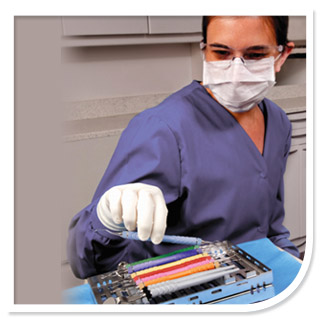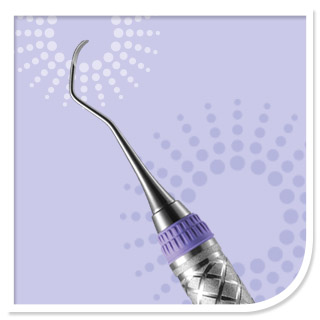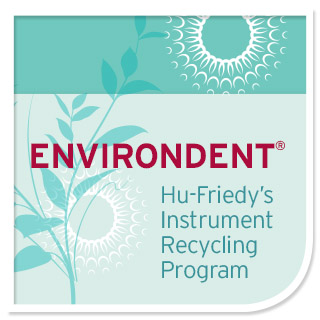Blog
Scalers vs. Sharks: Which Are More Misunderstood?

Diving into a few myths around scalers and looking at how sharks can help surface some truths.
Cue the Jaws theme music, it’s July, which means it’s time for the renowned Shark Week to make its annual appearance. Now woven into the mainstream of pop culture, shark-mania grips the nation by storm every July. It’s akin to a national holiday embraced by TV viewers everywhere. Last year, Hu-Friedy was inspired by Shark Week and brought a dental connection to this phenomenon. When we thought about it, we saw that sharks have a lot of interesting connections to dental, the most obvious one being their amazing teeth and how they use them. And so started “Sharp Week.”
As with sharks, dental instruments are subject to many myths and incorrect beliefs. Like a marine documentarian swimming among the sharks, we’re on a mission to remedy some of these myths and set the record straight. In this blog post, we will explore what might be learned from sharks and how that relates to the dental industry. Is re-tipping bad? Does a scaler last forever? Is there such a thing as a sharpen-free scaler? Let’s jump in.
A SCALER SHOULD LAST ABOUT A YEAR OR TWO, RIGHT?
A great white shark can live to seventy years of age. Your scalers cannot. The useful life of a scaler depends on a variety of factors. Consider how often are they used, sterilized, and sharpened, as well as the clinical applications they’re used for. Every now and then, it’s a good idea to look over instruments and “audit” them to make sure that they’re in the ideal condition. When they work effectively, you work efficiently.
HOW DO I "AUDIT" MY SCALER? 
The shape of a shark is specially designed to help it efficiently navigate long distances and maneuver around its prey with ease. Engineers have designed scalers and curettes to maneuver around tight spaces and effectively remove calculus. A shark wouldn’t be anywhere near as fast and efficient if its shape were changed, and neither will your instruments. Look through your current instrument offerings. Have any been re-tipped? Are they dull or chipped on the cutting edge or point? Are they bent or broken? Are the curettes pointed? Are the blades too thin? Here’s a “Sharp” tip: If the blade is 20% smaller than when it was new, the answer is “yes.” If the answer to any of these questions is a “yes,” then it’s time for them to be replaced.
For more help on instrument audits, check out our free performance assessment guide, Instrument Check-Up.
IS SHARPER BETTER? 
Sharks understand the value of maintaining sharp instruments. Most sharks lose tens of thousands of teeth during their lifetime. They have rows of teeth waiting to replace the old dull ones that are lost every few weeks. Likewise, your instruments should start sharp, and you should keep them that way. The sharper the scaler, the more efficient and productive you can be. Using a sharp scaler is the only way you can deliver the best clinical outcomes to your patients. Dull instruments are more difficult for you to use, and less comfortable for your patients. A possible result? burnished calculus – which can have an negative effect on a patient’s overall oral health. An easy way to test instrument sharpness is with plastic test sticks, which are inexpensive and effective. Test sticks won’t give you a “false positive” like plastic saliva ejectors will, nor will they dull the instrument. “Plastic test sticks are so inexpensive and much more effective than a saliva ejector, it’s crazy not to use them,” says Tami Wanless, RDH. Bonus: regular maintenance sharpening will extend the useful life of a scaler. We advise sharpening scalers regularly, but if you prefer a new instrument to a sharpened one, take advantage of our Environdent Program (More on that below.) 
IS THERE SUCH A THING AS SHARPEN-FREE?
While shark experts aren’t certain of the cause of Megalodon’s extinction, they unanimously agree that this prehistoric mega-shark is no longer around. People truly want to believe Megalodon still exists… but reality bites. There is no such thing as a “sharpen-free” scaler because all scalers get dull eventually. If a manufacturer offers “never sharpen” scalers, they’re really suggesting that the scaler be replaced as soon as it’s dull. “You have to sharpen your scalers in order for them to be effective,” says Wanless. “Who even likes using a dull pencil?” If you decide to go with a “never sharpen” scaler, ask questions to decide if it’s the best option. It’s important to know that sharpening these kinds of scalers may result in the coating flaking off, which can harm patients. Also, these scalers are not meant to be used on heavy calculus.
DOES A SUPERIOR MANUFACTURING PROCESS RESULT IN LONGER-LASTING INSTRUMENTS?
Sharks are famous for their sharp teeth; Jaws would be much less interesting if the sea villain had had dull teeth. Hu-Friedy created a sharper instrument through design and manufacturing innovation, making it easier to scale tough deposits, and providing a longer life of the instrument. A sharper design is the result of a superior manufacturing process that results in superior, longer-lasting products. Consider the new EverEdge 2.0: it is 72% sharper out of the box than our competitors’ scalers and at least 50% sharper after 500 strokes than those of our competitors’. That means fewer strokes, resulting in increased clinician and patient comfort.
IS A HARDER BLADE BETTER?
Bones are considered strong and durable, which is probably why most animals have them. A shark skeleton is made of cartilage. Since cartilage is more flexible than bone, a shark can turn around in a smaller space better than a bony fish - making sharks’ flexible skeletons more effective and likely to capture prey. Like cartilage in sharks, hardness in scalers does not equate to sharpness or effectiveness. Instead, look for the proper balance of firmness and flexibility to maximize tactile sensitivity. The great thing about the EverEdge 2.0[NB4] is that it is 45% sharper than the original EverEdge, while featuring new steel that is sharper, but not harder. This means that the instrument while being significantly sharper, is no more difficult to sharpen. What options do dental professionals have at the end of the useful life of their instruments? Shark teeth eventually fall out, ready to be replaced with newer, sharper teeth. Eventually, your scaler will need to be recycled, too. When the time comes at which a scaler cannot be sharpened any more, the best option is instrument recycling. By sending an instrument in to be recycled, the dental practice saves space on storing unusable instruments and benefits from kickbacks. For instance, our Environdent Program offers one free Hu-Friedy instrument for every 12 sent in to be recycled, no matter the brand. Moreover, the instruments are safely and responsibly recycled, helping the planet. After they’ve been cleaned and heat sterilized, used instruments can be shipped in a box to Hu-Friedy. A small, flat-rate box can hold 60 instruments, so the practice is eligible for five new instruments with just one mailing.
WHAT ABOUT re-tipping?
Because shark teeth are anchored in cartilage, as opposed to bone (like our own teeth), sharks frequently lose teeth. But how many of you have ever seen a toothless shark? None of you. That’s because sharks have rows and rows of teeth growing in their mouths. As teeth fall out in the front, teeth from the back migrate forward to replace them. What seems terrifying to most people is a fascinating point of trivia for dental clinicians. But what does this have to do with human dentistry or dental instruments? Well, when a shark’s tooth has met its useful lifespan and becomes dull, it is replaced – never re-tipped. Similarly, dental instruments should never be re-tipped; they should be replaced by an entirely new instrument once the tips have been damaged or worn beyond their useful life. Because of potentially dangerous consequences, no major dental manufacturer will retip instruments in the U.S. In fact, the FDA requires that re-tipped instruments be labeled as such so that the end user is aware of the risks they pose in infection control. re-tipping is not the simple process it sounds like. Don’t picture a screwdriver with magnetic bits that fit into the handle to switch between head types: re-tipping an instrument is an involved process that requires removing the “turner,” not just the tip. re-tipping requires forcing the removal of the working end and force-fitting its replacement, which often creates cracks in the handle where debris and fluid accumulate, making it harder to properly clean and sterilize. The replacement instrument is often a different size, shape, and composition than the original, and its balance will likely be lost in the process. It does not result in an identical replacement of the original instrument, and it introduces dangers to your staff and your patients. Simply put, the risks associated with re-tipping far outweigh any possible cost savings. So there you have it. Sharper instruments last longer. All instruments dull over time. Thinner or harder blades are not necessarily better, so it’s important to find the right combination of toughness and flexibility for your needs. And re-tipping is never a good idea.
For more information on how to keep your instruments, patients and team members safe, check out our Instrument Management & Infection Prevention guide.
FEATURED KEY OPINION LEADER

Read about Tami Wanless, MED, RDA - Key Opinion Leader. Tami Wanless is Adjunct Faculty in the Department of Dental Hygiene at the College of DuPage in Glen Ellyn, IL. She has a Master’s Degree in Adult Education from Northern Illinois University. Tami has twenty-seven years of experience in the dental field with twenty-four of these years in both the clinical and educational arenas. In her current role at College of DuPage, Tami is a clinical educator, the didactic instructor for Head and Neck Anatomy and Histology and the didactic and laboratory instructor in the Science of Dental Materials. Tami authored the lab manual for the Science of Dental Materials. She speaks on a multitude of dental hygiene related topics; predominately instrument sharpening and public health issues. Additionally, Tami is the founder of Sharp Advantage, a nationwide instrument sharpening business. When not educating, sharpening, scaling or active in professional organizations, you might find Tami plotting the next dental mission trip. Tami is committed to organized dentistry and quality patient care.
